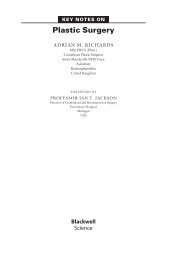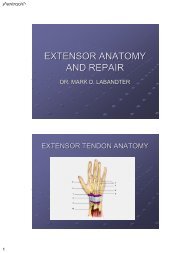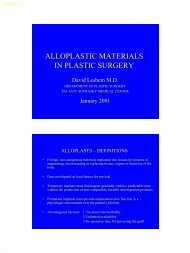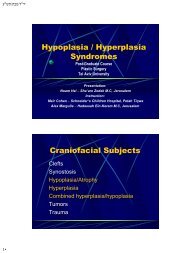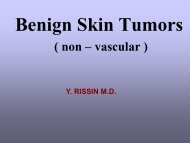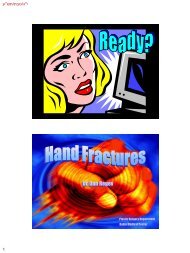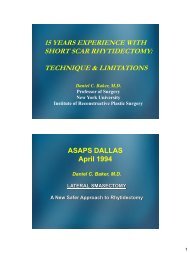Liposuction and Fat injection Liposuction Lipoplasty Lipolysis ...
Liposuction and Fat injection Liposuction Lipoplasty Lipolysis ...
Liposuction and Fat injection Liposuction Lipoplasty Lipolysis ...
You also want an ePaper? Increase the reach of your titles
YUMPU automatically turns print PDFs into web optimized ePapers that Google loves.
ע"<br />
שת/<br />
תבט/<br />
ג"<br />
י<br />
1<br />
<strong>Liposuction</strong> <strong>and</strong> <strong>Fat</strong> <strong>injection</strong><br />
Noam Hai M.D<br />
Sha’are Zedek Medical Center<br />
<strong>Liposuction</strong><br />
<strong>Lipoplasty</strong><br />
<strong>Lipolysis</strong><br />
Adipoaspiration<br />
Blunt Suction Lipectomy (BSL)<br />
Suction Assisted Lipectomy (SAL)<br />
Liposculpture
ע"<br />
שת/<br />
תבט/<br />
ג"<br />
י<br />
2<br />
Prehistory<br />
Ancient <strong>and</strong> Modern concepts<br />
of feminine beauty<br />
• Rhythmic cultures<br />
• Men - Dominant<br />
• Sun is worshiped<br />
• Straight line prevailed<br />
over the curve<br />
• Melodic cultures<br />
• Women - Dominant<br />
• Moon is worshiped<br />
• Curve predominates
ע"<br />
שת/<br />
תבט/<br />
ג"<br />
י<br />
3<br />
Rhythmic cultures: Egypt<br />
Rhythmic cultures: Egypt<br />
Mikerinos
ע"<br />
שת/<br />
תבט/<br />
ג"<br />
י<br />
4<br />
Rhythmic cultures: Egypt<br />
Amenofis<br />
Rahotep<br />
Rhythmic cultures: Greece<br />
Ilio-Femoro-Rotulian Ilio-Femoro-Rotulian-Line Line<br />
(IFRL)<br />
3 Graces 100 B.C
ע"<br />
שת/<br />
תבט/<br />
ג"<br />
י<br />
5<br />
Rhythmic cultures: Rome<br />
1/8<br />
Venus de milo<br />
200 B.C<br />
Rhythmic cultures: Renaissance<br />
Botticelli
ע"<br />
שת/<br />
תבט/<br />
ג"<br />
י<br />
6<br />
Rhythmic cultures: Renaissance<br />
Titian<br />
Rhythmic cultures: Renaissance<br />
Velasquez
ע"<br />
שת/<br />
תבט/<br />
ג"<br />
י<br />
7<br />
Rhythmic cultures: Renaissance<br />
Rubens<br />
Melodic cultures: Paleolithic age<br />
35,000 - 10,000 B.C<br />
• Willendorf Venus<br />
• Austria (1908)<br />
• 30,000 B.C<br />
• Most ancient<br />
Paleolithic statue
ע"<br />
שת/<br />
תבט/<br />
ג"<br />
י<br />
8<br />
Melodic cultures: Paleolithic age<br />
35,000 - 10,000 B.C<br />
• Laussel Venus<br />
• Pyrenean (1908)<br />
• 22,000 B.C<br />
Melodic cultures: Paleolithic age<br />
35,000 - 10,000 B.C<br />
• LespugneVenus<br />
• Italy (1922)<br />
• 20,000 B.C
ע"<br />
שת/<br />
תבט/<br />
ג"<br />
י<br />
9<br />
Melodic cultures<br />
Steatomelia<br />
Malta Dreamer<br />
Steatopygia<br />
Genetic Predisposition<br />
Ice age<br />
<strong>Fat</strong> = Energy store
ע"<br />
שת/<br />
תבט/<br />
ג"<br />
י<br />
10<br />
Clothing<br />
Hoop skirt<br />
Clothing<br />
The Bustle
ע"<br />
שת/<br />
תבט/<br />
ג"<br />
י<br />
11<br />
Today<br />
Lipodystrophy<br />
Surgical goal<br />
“...To achieve <strong>and</strong> maintain<br />
a slim <strong>and</strong> athletic figure…”<br />
Upper body / Lower body<br />
proportion
ע"<br />
שת/<br />
תבט/<br />
ג"<br />
י<br />
12<br />
Body contouring techniques<br />
1960-1970’s - Dermolipectomy<br />
• Abdominoplasty<br />
• Pitanguy‟s operation<br />
PRS 1964<br />
(Blair O. Rogers)<br />
Body contouring techniques<br />
Pitanguy’s operation - disadvantages<br />
• Long coarse scars<br />
• Delayed healing<br />
• Dehiscence<br />
• Recurrent deformities<br />
• New (Post-op)<br />
deformities<br />
• Taboo zones: Hips,<br />
knees, ankles
ע"<br />
שת/<br />
תבט/<br />
ג"<br />
י<br />
13<br />
“…You have to learn what<br />
others have done since you<br />
will not live long enough to<br />
make all the mistakes<br />
yourself…”<br />
Collapsing / Subcutaneous surgery<br />
• Closed blind lipectomy<br />
• Minimal (
ע"<br />
שת/<br />
תבט/<br />
ג"<br />
י<br />
14<br />
History<br />
“…The first malpractice suite<br />
for aesthetic surgery was<br />
against Dujarier<br />
after curette calf reduction<br />
(France 1929) …”<br />
Collapsing / Subcutaneous surgery<br />
Curette/Sharp technique<br />
• Schrudde Germany „64 - ‟72<br />
• The Fischers Italy „76 - ‟77<br />
• Kesselring Switzerl<strong>and</strong> „78<br />
& Meyer<br />
• Teimourian „77 - ‟81<br />
& Fisher
ע"<br />
שת/<br />
תבט/<br />
ג"<br />
י<br />
15<br />
Collapsing / Subcutaneous surgery<br />
Cannula/Blunt technique<br />
• Y.G IllouzFrance „77 - „80<br />
• Fournier France „79 - „82<br />
• & Otteni<br />
Curette technique - Lipexheresis<br />
Schrudde - Germany<br />
• 2-3 cm incisions<br />
• Long scissors blind<br />
undermining<br />
• Uterine curette removal<br />
of adipose tissue<br />
• Outer thighs<br />
• Inner knees<br />
• Calves & ankles<br />
Severe complications:<br />
• Persistent<br />
lymphorrhea<br />
• Hematomas<br />
• Skin necrosis<br />
• Unreliable results in<br />
other surgeon‟s h<strong>and</strong>s<br />
Ab<strong>and</strong>oned
ע"<br />
שת/<br />
תבט/<br />
ג"<br />
י<br />
16<br />
Curette technique - Suction curette<br />
Arpard & George Fischer - Italy 1977<br />
• First to combine<br />
suction to curettage<br />
• Cellusuctiotome - their<br />
portable device<br />
• Plannotome - pocket<br />
creation<br />
• Crushing -> Suction<br />
• Manual (Pinching) &<br />
visual (vacuum jar)<br />
monitoring<br />
• Suction drainage - 15d<br />
• Bed rest 5-6 days<br />
Complications:<br />
• Continuous oozing<br />
• Seromas with fibrous<br />
encapsulation<br />
• Skin undulations<br />
• High complication rate<br />
Curette - Kesselring technique<br />
Ulrich Kesselring - Switzerl<strong>and</strong> (1978)<br />
• Large scissors<br />
undermining<br />
• Sharp curette attached<br />
to vacuum machine<br />
• Tissue first cut then<br />
easily sucked out<br />
• Only trochanteric<br />
lipodystrophy<br />
• Young, good skin tone<br />
Good results
ע"<br />
שת/<br />
תבט/<br />
ג"<br />
י<br />
17<br />
Curette - Teimourian modification<br />
1977-1981<br />
• Sharp instruments:<br />
Scissors, modified Fascia<br />
Lata stripper<br />
• Uterine/Kesselring<br />
curette<br />
• More sites: Buttocks,<br />
knees,ankles,arms,flank<br />
• Combination procedures<br />
• 30% seroma - related to<br />
sharp dissection<br />
Curette technique - Conclusion<br />
• Cavity formation prior to suction<br />
• Destruction of most Fascio-cutaneous<br />
septa<br />
• Blood, nerves, lymph vessels disruption<br />
• Bleeding, Lymphorrhea<br />
• Persistent seroma -> prevention of skin<br />
retraction -> skin laxity & ptosis
ע"<br />
שת/<br />
תבט/<br />
ג"<br />
י<br />
18<br />
Curette technique - Conclusion<br />
Cannula/ Blunt technique<br />
Yves Gerard Illouz - France (1977-1980)<br />
• Blunt dissection<br />
• Sparing of the multiple<br />
septa containing<br />
neurovascular & lymphatic<br />
elements<br />
• Selective partial lipectomy<br />
• Sponge / Honeycomb /<br />
Spider-web pattern
ע"<br />
שת/<br />
תבט/<br />
ג"<br />
י<br />
19<br />
Cannula / Blunt technique<br />
Advantages over curette<br />
• Few taboo zones - practically any body part<br />
with excess fat<br />
• Several areas simultaneously<br />
• Multiple indications: Lipomas (Single/Multiple)<br />
Gynecomastia, Lipodystrophies<br />
• Adjunct to other procedures (Dermolipectomy)<br />
Abdominoplasty, Thigh lift, Breast reduction<br />
Rhytidectomy (esp. neck), flap defattening,<br />
Scar revision<br />
Cannula / Blunt technique<br />
Old subdivision<br />
• The original wet technique of Illouz:<br />
Mildly hypotonic solution + Hyaluronidase<br />
• The dry technique of Fournier<br />
• The new wet technique of Hetter:<br />
Low dose epinephrine
ע"<br />
שת/<br />
תבט/<br />
ג"<br />
י<br />
20<br />
Cannula / Blunt technique<br />
New subdivision<br />
Technique Infusate : Aspirate<br />
• Dry No infusate<br />
• Wet 1 : 2<br />
• Superwet 1-1.5: 1<br />
• Tumescent 3-6 : 1<br />
Adipose tissue in the past<br />
• Adipose tissue was long neglected by<br />
anatomists<br />
• Considered to be coverage of muscles, bones<br />
nerves <strong>and</strong> vessels<br />
• Inert / inactive reservoir
ע"<br />
שת/<br />
תבט/<br />
ג"<br />
י<br />
21<br />
Adipose tissue today<br />
• <strong>Fat</strong> tissue is vital for our life<br />
• Most energy rich fuel (9 Kcal/gr)<br />
• Dynamic <strong>and</strong> metabolically very active<br />
• Has physiological as well as pathophysiological<br />
role: NIDDM, Hypothyroidism, Hyperlipidemia<br />
• Daily turnover: 100-150 gr/day (70 kg adult)<br />
• X2 in stress, hunger, intense physical activity<br />
Adipose tissue - Main functions<br />
• Store <strong>and</strong> release FFA according to energy<br />
dem<strong>and</strong>s<br />
• <strong>Lipolysis</strong>: exerted by Lipoprotein Lipase (LPL)<br />
Triglycerides (TG) -> Glycerol + 3FFA<br />
• Lipogenesis:<br />
3FFA + Alfa Glycerol Phosphate -> TG<br />
• FFA Bind to Albumin, transported to peripheral<br />
tissue for oxidation
ע"<br />
שת/<br />
תבט/<br />
ג"<br />
י<br />
22<br />
FFA Outcomes<br />
Embryology<br />
• Adipose tissue evolves around subdermal<br />
capillary roots - 3 rd month<br />
• Adipoblasts - perivascular connective tissue<br />
• -> Preadipocytes -> TG production -><br />
Mature adipocytes<br />
• Replicative burst of adipocytes - Puberty<br />
thereafter their number is relatively fixed
ע"<br />
שת/<br />
תבט/<br />
ג"<br />
י<br />
23<br />
Embryology<br />
Bjornthorp’s theory<br />
Embryology<br />
• In severe obesity when adipocytes reach<br />
maximal capacity -> postadipocytes<br />
• They regain replicative properties<br />
• Upper limit to fat cell size: 2-5 X normal<br />
• Clinically: BW > 150% Ideal BW (IBW)<br />
• Hypertrophic growth -> Hyperplastic
ע"<br />
שת/<br />
תבט/<br />
ג"<br />
י<br />
24<br />
Patterns of obesity<br />
Adipose cellularity<br />
• Hyperplastic obesity: Rare type, begins in<br />
early childhood, increased cell number<br />
• Resistant to diet, exercise etc.<br />
• Hypertrophic obesity: Most common, begins<br />
in adulthood, increased cell volume<br />
• Responds to diet, exercise etc.<br />
• Android obesity: Upper body accumulation,<br />
most frequent in males.<br />
• High risk for cardiovascular, atherosclerotic<br />
<strong>and</strong> metabolic complications (IHD, HTN,<br />
CVA, NIDDM)<br />
• Gynecoid obesity: Lower body accumulation,<br />
most frequent in females<br />
• Low risk<br />
Patterns of obesity<br />
Distribution pattern
ע"<br />
שת/<br />
תבט/<br />
ג"<br />
י<br />
25<br />
Android<br />
Patterns of obesity<br />
Distribution pattern<br />
Patterns of obesity<br />
Distribution pattern<br />
Gynecoid
ע"<br />
שת/<br />
תבט/<br />
ג"<br />
י<br />
26<br />
Metabolism<br />
Active vs. “Reserve” fat<br />
• In animals many hormones regulate fat<br />
metabolism<br />
• In humans there are 2 hormones involved in<br />
acute regulation of fat metabolism:<br />
• Insulin & catecholamines<br />
• There are 2 receptors to catecholamines<br />
with antagonistic properties<br />
Metabolism<br />
Active vs. “Reserve” fat
ע"<br />
שת/<br />
תבט/<br />
ג"<br />
י<br />
27<br />
Metabolism<br />
Active vs. “Reserve” fat<br />
Metabolism<br />
“Reserve fat” was coined by Y.G Illouz<br />
Active fat cells<br />
• Beta 1 receptors<br />
• Lipolytic<br />
• Diet sensitive<br />
• Activated by: fasting,<br />
hunger, tobacco,<br />
caffeine<br />
• Upper body, Breast,<br />
Face<br />
Reserve fat cells<br />
• Alpha 2 receptors<br />
• Block lipolysis<br />
• Diet resistant<br />
• Resist amphetamines<br />
& derivatives<br />
• Lateral thighs, lower<br />
abdomen, buttocks
ע"<br />
שת/<br />
תבט/<br />
ג"<br />
י<br />
28<br />
Patterns of obesity<br />
Distribution pattern<br />
Anatomy - some facts<br />
• Women have higher % of fat (Thicker adipose<br />
tissue throughout)<br />
• Weight is genetically determined (Twin studies)<br />
• Infants have 1/5 the fat concentration of adults<br />
• Extremities lose fat with age<br />
• <strong>Fat</strong> tends to accumulate intraabdominally<br />
• Blacks tend to accumulate fat in the buttocks,<br />
further magnified by their lumbar lordosis
ע"<br />
שת/<br />
תבט/<br />
ג"<br />
י<br />
29<br />
Anatomy<br />
Anatomy
ע"<br />
שת/<br />
תבט/<br />
ג"<br />
י<br />
30<br />
Adipose tissue sections<br />
in different sites<br />
SL - Superficial Layer<br />
DL - Deep Layer<br />
SQF - Subcutaneous<br />
(Superficial) Fascia<br />
Anatomy - SFS<br />
• The SFS & relation to muscle fascia<br />
determines individual contour.<br />
• Skin creases <strong>and</strong> plateaus:<br />
• Creases - where SFS is most adherent to<br />
muscle fascia or periostium (Ant. & Post.<br />
midline, inguinal, gluteal creases<br />
• Bulges - over fat deposits the SFS is least<br />
adherent (LFD‟s)
ע"<br />
שת/<br />
תבט/<br />
ג"<br />
י<br />
31<br />
Anatomy - SFS<br />
• Supf. Fascial System (SFS) - The human<br />
derivative of the Panniculus Carnosus (FODOR)<br />
• Abdominal SFS = Scarpa‟s fascia<br />
• Panniculus Carnosus: A thin sheet of striated<br />
muscle lying within or just beneath the supf.<br />
fascia serving to produce local skin<br />
movements<br />
• Well developed in lower mammals. In human<br />
primarily represented by the platysma<br />
Anatomy - Cellulite
ע"<br />
שת/<br />
תבט/<br />
ג"<br />
י<br />
32<br />
Anatomy - Cellulite<br />
Cellulite<br />
Chesterfield sofa phenomenon
ע"<br />
שת/<br />
תבט/<br />
ג"<br />
י<br />
33<br />
Two types of cellulite<br />
Lockwood<br />
• Primary (Illouz‟s): hypertrophied fat within<br />
anchored retinacula cutis<br />
• Secondary: related to skin laxity, women >35<br />
Associated with: aging, sun, massive weight<br />
loss or liposuction<br />
• Supf. fat - SFS - skin stretch -> ptosis -><br />
pseudo LFD <strong>and</strong> cellulite<br />
• Corrected with surgical tightening of skin &<br />
SFS<br />
Nomenclature
ע"<br />
שת/<br />
תבט/<br />
ג"<br />
י<br />
34<br />
Anatomy - LFD’s<br />
(LFD) Localized <strong>Fat</strong> Deposit = Steatoma
ע"<br />
שת/<br />
תבט/<br />
ג"<br />
י<br />
35<br />
Well limited LFD<br />
Resembles lipoma<br />
1. Ileofemoral<br />
2. Middle femoral<br />
3. Ant. Femoral<br />
4. Post. extension<br />
Borders:<br />
Sup - supratrochanteric<br />
depression<br />
Ant - Fascia lata<br />
Trochanteric LFD<br />
Riding Breeches<br />
Trochanteric LFD<br />
Riding Breeches<br />
Inf - Middle 1/3 of thigh<br />
Post - Midpoint of gluteal<br />
crease
ע"<br />
שת/<br />
תבט/<br />
ג"<br />
י<br />
36<br />
In most cases:<br />
Supf. fat hypertrophy<br />
Except in:<br />
Blacks<br />
Brazilian mulattos<br />
Asians<br />
Buttocks<br />
Not a true LFD<br />
Buttocks<br />
Gluteal fold<br />
Ligament of Charpy = Ischiocutaneous<br />
ligament of Luschka: Triangular fibrous<br />
structure responsible for the fixed medial<br />
part of the gluteal crease (Hinge theory)
ע"<br />
שת/<br />
תבט/<br />
ג"<br />
י<br />
37<br />
Borders:<br />
Sup - 12 th ribs<br />
Ant - Abdominal mm.<br />
Inf - Iliac crest<br />
Post - Lumbar mm. +<br />
vertebral extension<br />
The hips<br />
Medial thigh<br />
Minimal amount of fat<br />
Must be preserved to protect vulva<br />
Hindrance - both sides rub when walking<br />
Poor redraping, natural depression
ע"<br />
שת/<br />
תבט/<br />
ג"<br />
י<br />
38<br />
Abdomen<br />
• LFD only in lower 1/2<br />
• Less than expected<br />
• Upper abdomen No LFD<br />
• Supf. fat hypertrophied<br />
• Dense/fibrous supf. <strong>Fat</strong><br />
• Iliac crests<br />
• Umbilicus<br />
• Pubis<br />
Borders:<br />
Knees<br />
Well demarcated LFD - Medial aspect<br />
Maximal bulge at the level of condyle<br />
Anteromedial extension should also be treated
ע"<br />
שת/<br />
תבט/<br />
ג"<br />
י<br />
39<br />
Thin deep layer<br />
Thick supf. <strong>Fat</strong><br />
(circumferential)<br />
Deltoid area<br />
pseudolipomatose<br />
Arms<br />
Face & Neck
ע"<br />
שת/<br />
תבט/<br />
ג"<br />
י<br />
40<br />
How to classify a roll ?<br />
LFD vs. supf. fat hypertrophy<br />
Diet responsiveness<br />
Early vs. late occurrence<br />
• Dorsal rolls<br />
• Iliac crest rolls<br />
Dorsal rolls
ע"<br />
שת/<br />
תבט/<br />
ג"<br />
י<br />
41<br />
“Special” deformities<br />
Violin deformity<br />
“Special” deformities<br />
Double gluteal fold / “Banana” roll
ע"<br />
שת/<br />
תבט/<br />
ג"<br />
י<br />
42<br />
“Special” deformities<br />
Marked gluteal depression<br />
LFD’s - Female
ע"<br />
שת/<br />
תבט/<br />
ג"<br />
י<br />
43<br />
LFD’s - Male
ע"<br />
שת/<br />
תבט/<br />
ג"<br />
י<br />
44<br />
Patient<br />
Evaluation<br />
Patients to avoid<br />
• Psychotics - Dysmorphophobia<br />
• “Dreamers” - Unrealistic expectations<br />
• Perfectionists - Minimal deformity raises<br />
substantial worry<br />
• Long history of:<br />
• Sun<br />
• Alcohol<br />
• Tobacco
ע"<br />
שת/<br />
תבט/<br />
ג"<br />
י<br />
45<br />
Obvious “poor” c<strong>and</strong>idates<br />
• Marked obesity (Relatively minimal change)<br />
• Poor skin quality especially obvious<br />
redundancy<br />
• Repeated weight gain & loss (Yo-Yo dieting)<br />
destroys elasticity & redraping capability<br />
• Age in correlation to skin quality: same skin<br />
quality 20 vs. 60 y.o prefer the older patient<br />
Obvious “good” c<strong>and</strong>idates<br />
• Young, slim, only a small bulge<br />
• Firm, smooth, tight skin<br />
BUT<br />
• Such patients are often extremely<br />
dem<strong>and</strong>ing <strong>and</strong> perfectionists<br />
• No defect, even an unnoticeable one will be<br />
forgiven
ע"<br />
שת/<br />
תבט/<br />
ג"<br />
י<br />
46<br />
“…a less dem<strong>and</strong>ing “poor”<br />
c<strong>and</strong>idate is sometimes a<br />
better c<strong>and</strong>idate than a<br />
“good” c<strong>and</strong>idate…”<br />
Unsolvable problems<br />
• Cellulite / Peau d‟orange<br />
• <strong>Liposuction</strong> may worsen cellulite<br />
• Small skin excess may become more<br />
pronounced<br />
• Double gluteal (“banana”) roll may be<br />
exaggerated<br />
• Size reductions: “the entire lower body from<br />
waist down”<br />
• Difficult / Non forgiving areas
ע"<br />
שת/<br />
תבט/<br />
ג"<br />
י<br />
47<br />
Diagnostic clinical tests<br />
• Quantity - Is there sufficient fat to remove?<br />
• Quality - Will there be enough skin retraction?<br />
• Prognostic - How will the area appear after<br />
suction?<br />
Quantity tests<br />
• There are “false positive” LFD‟s<br />
• Bony skeleton - coxa vara<br />
• Prominent muscles<br />
• Accordionization of skin<br />
• Omental / Intra-abdominal fat<br />
• Megacolon<br />
• LFD‟s < 1.5 cm are not for suction
ע"<br />
שת/<br />
תבט/<br />
ג"<br />
י<br />
48<br />
• Fingers / caliper<br />
• Divide in 2<br />
• Static / dynamic<br />
• Tiptoeing<br />
• Buttock<br />
contraction<br />
• Less fat in pinch<br />
Static pinch test<br />
Dynamic pinch test
ע"<br />
שת/<br />
תבט/<br />
ג"<br />
י<br />
49<br />
Dynamic test for trochanteric<br />
lipodystrophy<br />
Dynamic test for trochanteric<br />
lipodystrophy
ע"<br />
שת/<br />
תבט/<br />
ג"<br />
י<br />
50<br />
• Discover this<br />
pseudodeformity<br />
• Lateral & inferior<br />
weight transfer of<br />
buttocks<br />
• suction directed<br />
towards buttocks<br />
& hips<br />
Accordionization<br />
Trimming test
ע"<br />
שת/<br />
תבט/<br />
ג"<br />
י<br />
51<br />
• Lifting thigh skin<br />
towards iliac crest<br />
• Deformity does not<br />
disappear -> no<br />
skin excess<br />
• Good c<strong>and</strong>idate for<br />
suction<br />
• Xerogram<br />
• US<br />
• CT<br />
• MRI<br />
Lifting test<br />
Imaging
ע"<br />
שת/<br />
תבט/<br />
ג"<br />
י<br />
52<br />
• Appearance test<br />
• Percussion test<br />
Quality tests<br />
• Floating / Trembling test<br />
• Speed of retraction test (turgor)<br />
Reclining test
ע"<br />
שת/<br />
תבט/<br />
ג"<br />
י<br />
53<br />
If D
ע"<br />
שת/<br />
תבט/<br />
ג"<br />
י<br />
54<br />
• Manual compression<br />
reveals skin<br />
irregularities<br />
foretelling<br />
postoperative<br />
appearance<br />
Compression test<br />
The law of skin retraction<br />
If H
ע"<br />
שת/<br />
תבט/<br />
ג"<br />
י<br />
55<br />
Specific pitfalls<br />
• The fascia lata in trochanteric lipodystrophy<br />
• The double gluteal fold<br />
• The postoperative banana<br />
Planning the procedure<br />
• Which areas should be treated<br />
• How many areas should be treated in one<br />
session<br />
• What should be done in each area<br />
• When should the operation be scheduled
ע"<br />
שת/<br />
תבט/<br />
ג"<br />
י<br />
56<br />
Planning the procedure<br />
Preoperative markings
ע"<br />
שת/<br />
תבט/<br />
ג"<br />
י<br />
57<br />
Preoperative markings<br />
Preoperative markings
ע"<br />
שת/<br />
תבט/<br />
ג"<br />
י<br />
58<br />
Physics &<br />
Equipment<br />
Max vacuum =<br />
1 Atm
ע"<br />
שת/<br />
תבט/<br />
ג"<br />
י<br />
59<br />
1. Absolute vacuum<br />
(vaporization)<br />
2. Air “leak”<br />
The “ideal” Cannula
ע"<br />
שת/<br />
תבט/<br />
ג"<br />
י<br />
60<br />
Syringe pros:<br />
The “ideal” Cannula<br />
“Cobra”<br />
Syringe vs. pump<br />
• Less blood in aspirate<br />
• Less bruising & morbidity<br />
“Mercedes”<br />
In-line multihole<br />
• Reduced dead space (no vaporization)<br />
• faster healing shorter convalescence<br />
• Quiet O.R<br />
• No aerosol<br />
• Easy washing <strong>and</strong> storing fat<br />
• easy transportation to other facilities
ע"<br />
שת/<br />
תבט/<br />
ג"<br />
י<br />
61<br />
Syringe cons:<br />
• Time consuming<br />
• “Untidy”<br />
Syringe vs. pump<br />
In conclusion<br />
• Syringe is best suited for :<br />
• Small removals Size removals - pump<br />
• Touchup procedures<br />
• <strong>Fat</strong> graft harvesting<br />
• Superficial liposuction (?)<br />
Technique
ע"<br />
שת/<br />
תבט/<br />
ג"<br />
י<br />
62<br />
Pretunneling<br />
Criss-cross pattern
ע"<br />
שת/<br />
תבט/<br />
ג"<br />
י<br />
63<br />
Radiating tunnels<br />
Concealed incisions
ע"<br />
שת/<br />
תבט/<br />
ג"<br />
י<br />
64<br />
Concealed incisions<br />
Multiple entry stabs
ע"<br />
שת/<br />
תבט/<br />
ג"<br />
י<br />
65<br />
Positions - Supine<br />
1 2<br />
3<br />
Positions - Frog leg<br />
4
ע"<br />
שת/<br />
תבט/<br />
ג"<br />
י<br />
66<br />
Positions - Frog leg<br />
Positions - Prone
ע"<br />
שת/<br />
תבט/<br />
ג"<br />
י<br />
67<br />
Positions - Upright<br />
Intraoperative evaluation
ע"<br />
שת/<br />
תבט/<br />
ג"<br />
י<br />
68<br />
Fluids & Blood<br />
Wetting solutions<br />
Estimated hematocrit in aspirate<br />
• Dry (Fournier & Otteni) 5-54 (25%)<br />
30-46 (35%)<br />
• Original wet (Illouz) 20-25%<br />
100 NS + 20 Water + Wydase 1 unit/ml<br />
Overall 100-300 regardless of aspirated volume
ע"<br />
שת/<br />
תבט/<br />
ג"<br />
י<br />
69<br />
Wetting solutions<br />
Estimated hematocrit in aspirate<br />
• Wet (Hetter‟s solution) 8.7% -> 6.6%<br />
1 cc/cc<br />
0.25% Lidocaine + 1:400,000 Epinephrine<br />
• Tumescent (Klein 1990) @ 1%<br />
• 1-3 cc/cc or until turgid<br />
0.05-0.01% Lidocaine + 1:10 6 Epinephrine<br />
Superwet / Tumescence<br />
Pros Hunstad et al.<br />
• Eliminating the need for GA<br />
• Reduced blood loss<br />
• Reduced bruising -> Rapid recovery<br />
• Increased accuracy of removal (expansion<br />
of fat deposits)<br />
• Prolonged local analgesia<br />
• Better aesthetic result, less irregularities<br />
• High overall patient satisfaction
ע"<br />
שת/<br />
תבט/<br />
ג"<br />
י<br />
70<br />
Superwet / Tumescence<br />
Cons 1 Pitman et al.<br />
• Local anesthesia - not suited for all patients<br />
• Some may need sedation to fully relax<br />
• May require high -> toxic levels of lidocaine<br />
• Prolongs operative time<br />
• Although blood loss reduced, don‟t forget to<br />
prepare blood<br />
• May cause fluid overload -> cardiac / pulm.<br />
decompensation / Congestive failure<br />
Superwet / Tumescence<br />
Cons 2 Pitman et al.<br />
• May cause fluid overload -> cardiac/pulmonary<br />
decompensation -> Congestive heart failure<br />
• Aspirate contains more water -> Larger<br />
volumes should be removed (compensation)<br />
• Large clysis changes the feel & appearance of<br />
tissue -> altered tactile & visual cues to<br />
determine endpoints of liposuction
ע"<br />
שת/<br />
תבט/<br />
ג"<br />
י<br />
71<br />
Blood & fluid replacement<br />
“Internal burn” theory<br />
Blood & fluid replacement<br />
• Hetter estimated 1% drop in Hct for 150cc<br />
• Autologous blood recommended for<br />
removals > 1500cc<br />
• Pitman & Holzer: Autologous blood<br />
indicated if at the end of procedure:<br />
Hct25%<br />
• Removals of >15% BSA increase morbidity<br />
out of proportion<br />
• Autologous Blood increases safety
ע"<br />
שת/<br />
תבט/<br />
ג"<br />
י<br />
72<br />
“…Almost all lethal<br />
complications of liposuction<br />
stem from failure to maintain<br />
normal intravascular volume<br />
with resultant poor tissue<br />
perfusion…”<br />
Blood & fluid replacement<br />
Remember:<br />
• Fluid loss continues for >36 hours postop.<br />
(3rd space)<br />
• Clinical monitoring (Pulse, BP, Orthostatic<br />
BP, urine output) more accurate than Hct.<br />
• Maintain fluids to prevent tissue hypoxia,<br />
oliguria <strong>and</strong> renal failure,<br />
hemoconcentration <strong>and</strong> thromboembolism
ע"<br />
שת/<br />
תבט/<br />
ג"<br />
י<br />
73<br />
Dry<br />
Blood & fluid replacement<br />
Blood & fluid replacement<br />
3000cc<br />
IV 2:1 + 2 unit<br />
autologous blood<br />
Wet<br />
2500cc<br />
1:1 IV Intraop +<br />
1:1 IV Postop +<br />
1-2 units<br />
autologous blood<br />
for Hct
ע"<br />
שת/<br />
תבט/<br />
ג"<br />
י<br />
74<br />
Dressing / pressure garment<br />
Dressing / pressure garment
ע"<br />
שת/<br />
תבט/<br />
ג"<br />
י<br />
75<br />
5 Phases of convalescence<br />
Hetter<br />
1. B<strong>and</strong>age phase (days 1-7)<br />
2. <strong>Fat</strong>igue phase (days 7-15)<br />
3. Disappointment phase (days 16-25)<br />
Massage is invaluable in this phase<br />
4. Relief phase (days 26-42)<br />
5. Satisfaction phase (>6 weeks)<br />
Complications
ע"<br />
שת/<br />
תבט/<br />
ג"<br />
י<br />
76<br />
Complications<br />
• Severe (Major, Mortal) complications<br />
• Minor complications<br />
• Sequelae / Transient conditions<br />
• Aesthetically unfavorable results<br />
Severe complications<br />
1. Fluid overload -> Pulmonary edema (CHF)<br />
2. Pulmonary embolus (PE)<br />
3. <strong>Fat</strong> Embolism Syndrome (FES)<br />
4. Myocardial infarction (MI)<br />
5. Renal failure (ARF)<br />
6. Massive (overwhelming) infection<br />
7. Viscus perforation: intestine, liver, spleen,<br />
lungs (pneumothorax)<br />
8. Lidocaine toxicity
ע"<br />
שת/<br />
תבט/<br />
ג"<br />
י<br />
77<br />
Severe complications<br />
Survey among US & Canadian surgeons<br />
Pitman & Teimourian 1985<br />
Overall complication rate - 9.3%<br />
Unfavorable aesthetic results - 20.7%<br />
Severe complications<br />
The commission an surgical suction lipectomy<br />
of the ASPRS 1987<br />
• Among 100,00 procedures in 5 years<br />
• 11 deaths 9 Major morbidity<br />
4 Suction alone 3 Pulmonary Emb.<br />
2 Nec. Fasciitis 3 <strong>Fat</strong> Embolus<br />
2 Hypovolemic shock or FES 2 Massive infection<br />
7 Combination 1 Perforation<br />
4 Pulmonary Embolus<br />
1 Infection & DIC<br />
1 FES + 1 Probable FES
ע"<br />
שת/<br />
תבט/<br />
ג"<br />
י<br />
78<br />
Severe complications<br />
• “...The most frequent potential hazardous<br />
complication is hypovolemia from massive<br />
aspiration & 3rd space creation…”<br />
• Can be prevented by:<br />
• Intraoperative blood loss monitoring<br />
• Wet / tumescent technique<br />
• Maintain IV access for fluids & blood replacement<br />
• 24 hrs urine output monitoring<br />
Complications<br />
Dillerud PRS 1991<br />
• 2000 pts. 3511 procedures<br />
• Inclusion: Healthy (incl. stable diabetics, well<br />
controlled HTN)<br />
• Exclusion: BMI >35<br />
• Overall complication rate - 1.2% Excessive<br />
bleeding, Allergic reactions, dermatitis, anesthesia related<br />
complications, phlebitis, pneumonia, hypertrophic scars,<br />
persistent dysesthesia<br />
• Unfavorable results - 10.8% Asymmetry, underresection,<br />
skin irregularities.<br />
• Medial thigh, buttocks, ankles & calves - high % of<br />
complications & unfavorable results
ע"<br />
שת/<br />
תבט/<br />
ג"<br />
י<br />
79<br />
Long term patient satisfaction<br />
Dillerud PRS 1993<br />
• Overall satisfaction rate - 76%<br />
• 14% less satisfied<br />
• 6% dissatisfied<br />
• 4% unsure<br />
• Buttocks - highest dissatisfaction<br />
• Gynecomastia / submental area - highest<br />
satisfaction<br />
1. Anemia<br />
2. Seroma<br />
3. Hematoma<br />
Minor complications<br />
4. Surgical site infection<br />
5. Sensory N. damage - Persistent dysesthesia<br />
or hypesthesia<br />
6. Muscle or muscle fascia damage with<br />
persistent pain<br />
7. Pseudobursa formation (encapsulated<br />
seroma)
ע"<br />
שת/<br />
תבט/<br />
ג"<br />
י<br />
80<br />
Sequelae / Transient conditions<br />
1. Mild over / under resection<br />
2. Temporary hypesthesia<br />
3. Mild waviness<br />
4. Occasional minor dent or divot<br />
5. Faint hemosiderin deposits<br />
6. Transient pain<br />
7. Mild degree of asymmetry<br />
8. Transient fatigue<br />
Sequelae / Transient conditions<br />
• Almost inevitable<br />
• Vary substantially from patient to patient<br />
• Usually resolve within 3 months<br />
• Some areas take longer to recover<br />
Neck Knees Iliac-crests Thigh Abdomen Calves<br />
Fast Slow
ע"<br />
שת/<br />
תבט/<br />
ג"<br />
י<br />
81<br />
Aesthetically unfavorable results<br />
• Grey zone, thin line between anticipated<br />
sequelae <strong>and</strong> unfavorable results<br />
• Much related to skin redraping capabilities<br />
• Mentioned those that lead to law suites<br />
Aesthetically unfavorable results<br />
1. Grooving of the skin<br />
2. Multiple dents / divots<br />
3. Localized overresection “Dishing out”<br />
4. Generalized overresection - Flat thighs,<br />
buttocks, skinny appearance<br />
5. Skin necrosis<br />
6. Androgynous appearance<br />
7. Buttock ptosis<br />
8. Skin adhesions to muscle fascia
ע"<br />
שת/<br />
תבט/<br />
ג"<br />
י<br />
82<br />
Aesthetically unfavorable results<br />
Grooving<br />
Aesthetically unfavorable results<br />
Multiple dents & divots
ע"<br />
שת/<br />
תבט/<br />
ג"<br />
י<br />
83<br />
Aesthetically unfavorable results<br />
Skin necrosis<br />
Aesthetically unfavorable results<br />
Perforation through striae distensae
ע"<br />
שת/<br />
תבט/<br />
ג"<br />
י<br />
84<br />
Minimizing unfavorable results<br />
1. Careful patient selection<br />
2. Thorough preoperative evaluation &<br />
documentation<br />
3. Use small diameter cannulas<br />
4. Use multiple incisions<br />
5. Criss-cross<br />
6. Radial tunneling<br />
7. Peripheral mesh undermining<br />
8. Feathering the edges<br />
Minimizing unfavorable results<br />
“Touch-up”s <strong>and</strong> “redo”s not sooner than 6<br />
months<br />
Try deep massage to correct mild<br />
irregularities <strong>and</strong> waviness
ע"<br />
שת/<br />
תבט/<br />
ג"<br />
י<br />
85<br />
Minimizing infections<br />
• Totally sterile field (No discounts..)<br />
• Do not touch cannula barrel<br />
• Most likely site of infection treated last<br />
(Inner thighs)<br />
• Avoid perianal / perivaginal incisions<br />
• Perioperative Abx ???<br />
Endermologie (LPG)
ע"<br />
שת/<br />
תבט/<br />
ג"<br />
י<br />
86<br />
Statistics<br />
Statistics - Females
ע"<br />
שת/<br />
תבט/<br />
ג"<br />
י<br />
87<br />
Statistics - Males<br />
Superficial liposuction<br />
Marco Gasparotti - 1992<br />
• After “traditional” deep liposuction supf. fat<br />
may still be thick -> gravitational ptosis<br />
• Small diameter cannulas, close tunnels,<br />
peripheral mesh undermining<br />
• Controlled subcutaneous scar contraction<br />
• Promotes effective skin retraction<br />
• Especially effective in: Lateral thigh,<br />
banana, redo
ע"<br />
שת/<br />
תבט/<br />
ג"<br />
י<br />
88<br />
Superficial liposuction<br />
Gasperoni - 1989-1994<br />
• MALL = Massive All Layer <strong>Liposuction</strong><br />
• Combined deep adipoaspiration with<br />
subdermal defattening<br />
• Mercedes cannula, 2mm diameter<br />
• 404 procedures 293 pts. Excellent results<br />
• Goal: To reduce as much as possible the<br />
thickness of all adipose layers <strong>and</strong> to promote<br />
effective skin retraction<br />
• Flaccid skin<br />
Superficial liposuction<br />
Indications<br />
• Rippling irregularity<br />
• “Cottage cheese” deformity<br />
• Two types of skin (Matarasso):<br />
• Type A - Flaccid pseudoptotic skin Max benefit<br />
from supf. liposuction: Neck, dorsal rolls,<br />
outer thighs, banana<br />
• Type B - (Cellulite) Outer & Ant. thighs<br />
• Use pickle-fork cannula
ע"<br />
שת/<br />
תבט/<br />
ג"<br />
י<br />
89<br />
UAL<br />
PAL
ע"<br />
שת/<br />
תבט/<br />
ג"<br />
י<br />
90<br />
SAL / UAL / PAL<br />
Mega liposuctions
ע"<br />
שת/<br />
תבט/<br />
ג"<br />
י<br />
91<br />
Combination procedures





